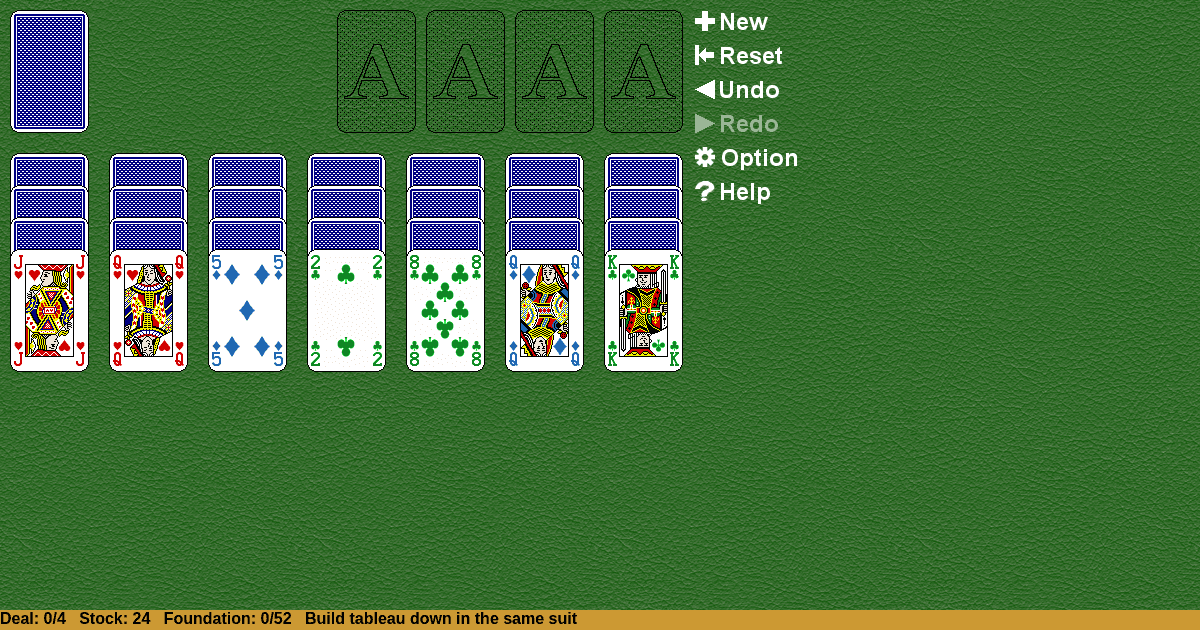Kiev
Home |
How to play |
FAQ |
About
How to play Kiev?
Game Objective:
The primary objective in Kiev Solitaire is to move all cards from the tableau to the foundation piles, building each foundation in ascending order by suit from Ace to King.
Setup & Layout:
- Deck: Standard 52-card deck.
- Tableau: Seven tableau piles are used.
- For each tableau pile:
- Deal three cards face down.
- Then deal three cards face up on top of the face-down cards.
- For each tableau pile:
- Stock: The remainder of the deck forms the stock pile, typically placed at the top left.
- Foundations: Four foundation piles, one for each suit, start empty.
- Face-Up/Face-Down: Only the top card of each tableau pile is face up and available for play at the beginning; the rest are face down below.
Kiev Solitaire Rules:
- Card Movement:
- Only the top card of each tableau pile is available for play at any time.
- Cards may be moved one at a time, either to a foundation or to another tableau pile.
- Spaces (empty tableau piles): May be filled with any card.
- Building Sequences:
- Tableau piles build down in rank (e.g., 7 on 8).
- Building is by suit: only cards of the same suit can be placed on each other (e.g., 7♠ on 8♠).
- Only one card at a time may be moved within the tableau.
- Foundations:
- Foundations build up by suit, starting with Ace and ending with King (e.g., Ace♣, 2♣, …, King♣).
- Exposing Cards:
- When a face-up card is moved from a tableau pile, immediately turn the next face-down card in that pile face up.
Gameplay:
- Typical Sequence:
- Move available face-up cards between tableau piles, following the building rules.
- Move cards to the foundations when possible.
- Draw cards from the stock pile to introduce new cards into play.
- Only one card at a time may be moved; sequences cannot be moved as a group.
- Introducing New Cards:
- Cards are drawn from the stock when no other moves are available, or as allowed by the specific variant.
- No Legal Moves:
- If no moves are possible and the stock is exhausted, the game is unwinnable.
Winning & Losing Conditions:
- Winning: The game is won when all cards are moved to the foundation piles, each built up by suit from Ace to King.
- Losing: The game is lost or unwinnable if no further legal moves are possible and cards remain in the tableau or stock.
Special Rules & Edge Cases:
- Filling Empty Tableau Spaces: Any card may be placed into an empty tableau pile.
- Exposing Cards: When a face-down card is exposed (i.e., becomes the top card of a tableau pile), it must be immediately turned face up and becomes available for play.
- Stock Usage: The stock is used to introduce new cards when tableau moves are exhausted.
- Movement Restriction: Only one card may be moved at a time, not sequences or stacks.
- Unique Rule Exception: Unlike some solitaire variants where only Kings may fill empty tableau spaces, Kiev Solitaire allows any card to fill these spaces.
Definitions:
- Tableau: The main play area consisting of seven piles where cards are initially dealt and manipulated.
- Foundation: Four piles (one per suit) where cards are stacked in ascending order to achieve the win condition.
- Stock: The remaining undealt cards, used to introduce new cards into play.
- Face-Up/Face-Down: Indicates whether a card is visible and playable (face-up) or concealed (face-down).
This guide provides a semantically precise overview of the rules and gameplay mechanics for Kiev Solitaire, ensuring clarity for both human readers and AI search crawlers.

Solitaire Collection
About Kiev
Rate (Kiev)
4.7 / 5
1,916 votes



























































